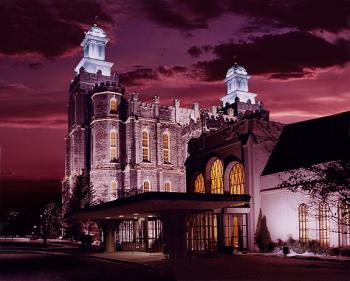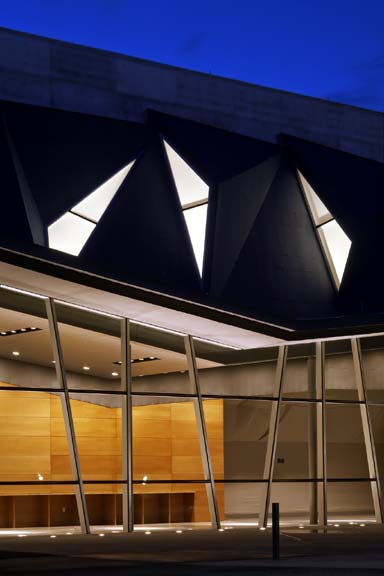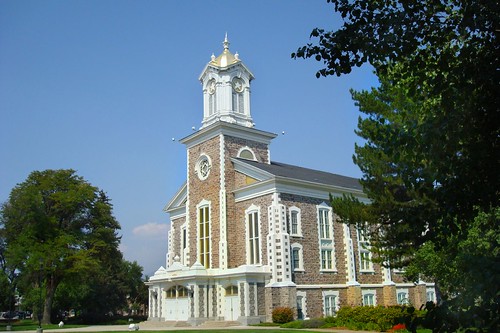Coolest Cache structures ...
The Herald Journal and The Heritage Foundation Newsletter,
Given the variety of architecture in Cache Valley, it’s hard to pick just 10 buildings that could be described as the “neatest” or “coolest.”
But we tried.
There’s a number of structures that could have made the list, and in fact, it was a struggle for Herald Journal staff members to agree on the top 10. Buildings like the Utah Theatre, the Smithfield Armory, Logan’s 1st Ward LDS chapel on 100 South, the roof of the White Owl, Cafe Sabor, the Old Rock Church in Providence, the current Architectural Design West building and several homes in Historic Downtown Logan all were given heavy consideration.
But in the end, we could only include 10, and here they our, our picks for the valley’s 10 “coolest structures.”
1. LDS Temple, 175 N. 300 East in Logan

Finished in the 1880s, the LDS Temple inevitably topped this list, based on its size, situation, age and relevance to Cache Valley residents. However, not every Herald Journal reader agreed that the limestone castellated-style building should be on the list.
Calling it gothic/Victorian (which some people said “strangely works”), one reader wrote, “It looks like someone put salt and pepper shakers in the turret towers of a medieval castle. Horrible combination.”
On nine acres, the 119,619-square-foot building that hosts the “salt and pepper shakers” atop is the second LDS temple built in Utah. The five-story building was started in May 1877 and dedicated in May 1884.
Originally, a buff-colored sandstone was used to detail shaping and, reportedly, to hide the dark, siliceous limestone hauled from Logan Canyon then seen as unattractive. In the 1900s, the paint was allowed to weather and the limestone uncovered.
The temple is now a hub of religious activity, with regular patrons throughout the week and a flood of brides and grooms on weekends. Usually the first structure people see when coming out of Wellsville Canyon, it embodies the reason Cache Valley is the size it is today.
2. Dr. Pierce barn off U.S. Highway 89/91 north of Wellsville

Hailed 100 years ago as one of the most powerful and helpful medications a woman could have, a barn advertisement for Dr. Ray Vaughn Pierce’s famous
“Woman’s Tonic” is now a historical landmark in Cache Valley.
Near Wellsville on U.S. Highway 89/91 the “Dr. Pierce” barn is actually one of two in the valley that sport ads for 19th and 20th century medications. The second is west of Richmond and more obscure than the Wellsville landmark.
With similar barns across the country — several in Oregon, Washington, New York and California at least looking strikingly familiar to anyone who’s driven southbound from Logan, the ad, “The woman’s tonic: Dr. Pierce’s favorite prescription” is a relic of the past. Painting advertisements on barns was common in the 19th and 20th centuries and Pierce’s wildly popular medicines that treated women’s diseases, cancer, digestive illness, fatigue, heartaches and menstruation definitely made it to Cache Valley.
The barn, owned by Evan Stevenson, was fortified in the late 1990s and restored in the fall of 2002. After some complained the letters were restored a little too much, a crew came in July 2003 to reverse the process by weathering the letters to make them appear closer to originality.
Photographs of Wellsville’s Dr. Pierce’s barn can be found alongside other Dr. Pierce photos from around the nation on poster and art retail Web sites.
3. Historic County Courthouse, 199 N. Main Street

In 1882, the County Court retained the Logan LDS Temple architect Truman O. Angell Jr. to design a new courthouse. For $17,814, Cache County residents saw their Main Street courthouse go up with locally pressed brick and Logan Canyon timber.
More than 120 years later, $2.5 million would go into restoring the building, that until 2003 was the oldest continually used government building in the state.
The Historic County Courthouse was slated for demolition more than once over the past couple of decades, but proponents of keeping the courthouse around won the fight. Former Logan Mayor Newell Daines oversaw restoration.
The modern building has been open for about a year to the public and hosts the Cache County Council meetings. Other offices and the Visitor’s Bureau now call the facility home.
4. Old Main, USU campus

One reader called Old Main and the Logan LDS Temple necessary “on any list of important and beautiful buildings in Cache Valley.”
Originally the “College Building,” this university landmark is second to the temple in it’s prominence around the valley. Built quickly after Utah’s Board of Trustees approved the $20,305 construction project in 1889, the majority of the building was completed within a year and the entire structure erected by 1901.
Old Main holds at least one state record. The “gothic landmark” is the oldest continuously used structure at a college or university in Utah. Its plans, designed by C.L. Thompson, were chosen by the Trustees from among four choices.
Now home to the university president’s offices, major university offices and several classrooms, Old Main’s prominence in Cache Valley resident’s minds is emotional as well as physical. The building appears in countless engagement, bridal, graduation, family and landscape photographs that grace photo albums and the walls of homes across the state.
5. St. John’s Episcopal Church, 85 E. 100 North

Founded in 1873, the St. John’s Episcopal Church was the first church in the valley not of the LDS faith. Eventually dedicated in 1909, the present church and parish hall are historic structures in Cache Valley, listed on the state’s register of historic sites.
Since its construction, the sometimes called “western, Romanesque gothic” building has changed, prompting one Herald Journal reader to nominate the church: “What about St. John’s Episcopal Church? The oldest Protestant church in the valley that was expertly remodeled to combine the old with the new. A great feat.”
Recent changes have included the 1983 addition of the large stained glass window on the south facade of the building, depicting Gospel of St. John scenes. In 1997, the church purchased the house west of the parish hall and completed a building project in 2004, increasing the size of the structure and making it more easily accessible.
Today, St. John’s hosts a parish of about 150 local families.
6. Manon Caine Russell Kathryn Caine Wanlass Performance Hall, USU campus


ARTEC
One of three USU buildings to make our list, the new recital hall is not one of the “coolest” because it was paid for mainly with money from the largest private gift in university history, although a notable detail.
Even though at least one reader disagreed with the performance hall’s unique architecture, The Herald Journal staff decided that, in this case, unique was a good thing. The 20,000-square-foot, $10.5 million performance hall was designed not just to provide musical experiences, but to have a presence on campus with its exterior sculpted to look like mountains.
With $6.3 million in money gifted from sisters Kathryn Caine Wanlass and Manon Caine Russell, chief designer Vinicius Gorgati explained that necessity after the hall’s 2004 announcement.
“This building is located at an important edge of the campus. It is also the first building within a completely new arts precinct. It needed to be dramatic, but in a way that responded to an exquisite natural setting,” Gorgati said.
7. Wells Fargo building, corner of Main and Center streets

Before it was the Wells Fargo Building it was the First Security Bank building. Before that? Hotel Eccles.
The building at 5 South Main replaced the Thatcher Opera House, which burned down the same day the Titanic sank, and with the large bank sign on top of it in recent years, its became a landmark of downtown Logan.
The four-story building is one of the taller structures in town, and a recent remodel of the bank area on the first floor has created a first-class classic interior feel.
8. LDS Tabernacle, northeast corner of Center and Main streets

arbyreed
At the center of the community, the LDS Tabernacle is the backbone of
Logan’s downtown. It defines Main Street in Logan to locals and visitors.
In the 1860s Logan officials started talking about the necessity of a larger meeting place, according to former historian A.J. Simmonds’ research. By 1874, the 130- by 65-foot building was under construction using volunteer labor and stone from local quarries.
However, the work slowed, according to Simmonds, when the temple was announced three years later. It took until 1891 for the entire building to be dedicated by Wilford Woodruff.
The tabernacle is no longer a regular meeting place for church congregations, excepting stake conferences and other large group LDS meetings, but hosts a variety of other events, including tours, Noon Music at the tabernacle and the annual Summerfest Arts Faire.
9. Merrill-Cazier Library, USU campus

This building became the newest attraction on campus even before it was dedicated in April 2006, with students detouring past construction fences and work crews.
Rumors of automated storage, large study areas and the newest technology became truth after the university merged two libraries to open the state-of-the art Merrill-Cazier Library.
One reader suggested the new 305,0000-square-foot structure for the HJ’s list: “Also, a more recent building that is technologically and architecturally incredible is the new Merrill-Cazier library on campus. Very ‘cool.’”
10. First District Courthouse

It’s a large stone and glass building with lots of right angles, and one that many have lambasted as “sticking out like a sore thumb” in an otherwise classically designed downtown, but it’s the things inside the courthouse that we think are “cool.”
Compared to its predecessor, the 1st District Courthouse is a model of technology and security. The building features courtrooms with several cameras and advanced audio recording equipment designed to create a visual record of everything that happens in court. The building also has secure, separate hallways within the structure, which allow guards to transport inmates from a holding area on the first floor to the courtrooms without every having contact with the public.
— By Emilie H. Wheeler



